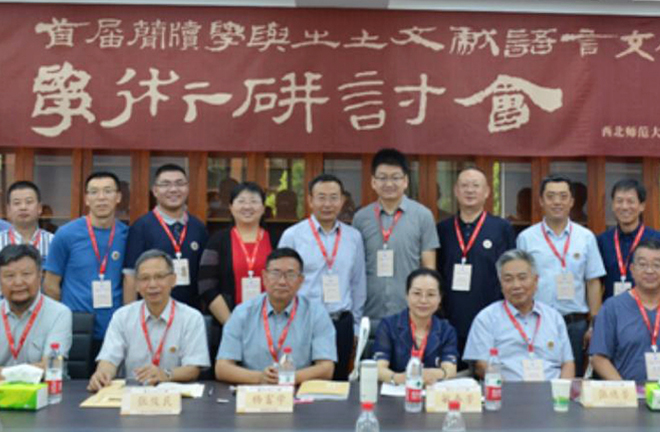Seminar probes unearthed documents

A seminar on the Chinese language and writing system in unearthed documents was held in Lanzhou, Gansu Province, on August 7. Photo: NWNU
LANZHOU—A seminar on the study of bamboo and wooden slips and the language and writing system in unearthed documents was held in Lanzhou, Gansu Province, on August 7. Scholars conducted discussions on theories, research methods, the status quo, and prospects in the field.
Supplementing handed-down documents
“Inscriptions on oracle bones, bamboo and wooden slips in the Han (206 BCE–220) and Jin (265–420) dynasties, and Dunhuang documents are not merely excavated historical literature, but also supplements to handed-down documents,” said Zhang Defang, a research fellow from the Gansu Jiandu Museum. Unearthed literature in such forms as bamboo and wooden slips and Dunhuang documents record manifold information of ancient China regarding calendars, pharmacopoeia, historical geography, local conditions and customs, society and economy, politics and law, culture and education, science and technology, ethnic exchanges, and military defense. They open a window for later generations to understand the development of ancient society and the lives of ancient people, and provide historical research with supporting materials in political, economic, ideological, cultural, and military aspects. Unearthed documents greatly supplement descriptions of handed-down documents such as Shiji (Records of the Grand Historian) and Hanshu (The Book of Han), thus possessing major historical and academic value.
According to Zhang Bojiang, director of the Institute of Linguistics at the Chinese Academy of Social Sciences (CASS), the study of language and writing systems that centers on oracle bone inscriptions, bronze inscriptions, bamboo and wooden slips, and other unearthed documents is a basic discipline of philosophy and social sciences. It greatly expands the research space for language and writing systems. Spanning from traditional philology, phonology, and exegetics, to modern lexicology and grammar, many fields in the history of the Chinese language are influenced by the unique role played by unearthed document studies such as oracle bones, bamboo and wooden slips, and Dunhuang literature.
Compiling and collating
“Compiling and collating unearthed documents such as bamboo and wooden slips and Dunhuang documents is an extremely difficult research task,” said Zhu Jianjun, curator of Gansu Jiandu Museum. The complex contents of bamboo and wooden slips and other documents call for multidisciplinary research and compilation to restore historical and contextual truth. At the same time, it is necessary to leverage the latest cutting-edge technology to strengthen the digital collection of bamboo and wooden slips for better research, display, and utilization.
As a large number of unearthed documents have been compiled and published, thus forming a complete diachronic sequence, the study of the Chinese language and writing system has benefited from rich new materials. With unparalleled favorable conditions unavailable to predecessors, the study of the Chinese language and writing system has ushered in a new stage of development. According to Wang Guiyuan, director of the Wu Yuzhang Institute of Chinese Language and Characters at Renmin University of China, the continuous discovery, compilation, and publication of massive numbers of excavated documents such as bamboo and wooden slips and Dunhuang documents will definitely help people understand the Chinese language and writing system more systematically, deeply, and comprehensively. It is hoped this will promote the innovative development of linguistic theory and research methods.
Chinese language and writing system
The Chinese language and writing system are one of the most important signs of the Chinese nation and a critical carrier of Chinese history and culture. Greater efforts are needed to develop juexue, or “studies of lost knowledge” such as oracle bone studies, bamboo and wooden slips studies, and Dunhuang studies, in order to build a theoretical system of the Chinese language and writing system with distinctive Chinese features.
“Niche juexue contributes to constructing philosophy and social sciences with Chinese characteristics,” said Han Gaonian, vice president of Northwest Normal University. Research of the Chinese language and writing system must break free from the constraints of Western theories and of excessive disciplinary subdivision. Interdisciplinary collaborative research should be strengthened between the discipline and historiography, archaeology, and studies of ancient Chinese texts, continuing the in-depth research of the Chinese language and writing system.
In November 2020, eight departments including the Publicity Department of the CPC Central Committee, the Ministry of Education, and the State Language Commission, jointly launched a project for the inheritance and development of the ancient Chinese writing system and Chinese civilization, injecting strong developmental momentum into niche juexue such as bamboo and wooden slips and Dunhuang studies.
In Wang’s view, linguistic studies must put materials first. The only way for researching the Chinese language and characters lies in proceeding from Chinese materials themselves, through the interpretation of these documents discerning the development context and changing laws of the Chinese writing system, and forming our own theoretical system.
“Research of bamboo and wooden slips and linguistic research on unearthed documents are an integral part of basic disciplines,” said Zhao Changcai, a research fellow from the Institute of Linguistics at CASS. Enhanced efforts are called for to cultivate talent for juexue such as oracle bone studies and bamboo and wooden slips, and build broad academic platforms. This will attract more young scholars to be involved in research of ancient languages and writing systems, raising the innovation ability and academic influence of juexue.
Edited by YANG LANLAN
